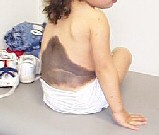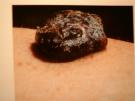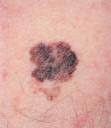Although
childhood malignant melanomas are rare, physicians and parents must
keep an eye out for them. About 2% of all melanomas appear in
children, but the types that commonly occur in children are
different from those found in adults. Melanomas in children arise
from three things: 1. congenital nevi (moles that are there at
birth), 2. de novo nodular nevi (moles that come up new as they
grow older), and 3. superficial spreading melanomas that are sun
induced from moles that have been there for years.
Although
70% of melanomas in adults are sun induced and are superficial
spreading melanomas, about 80% in children arise from congenital
moles or de novo nodular lesions. There are very different concepts
of melanoma in childhood.
1.
Congenital moles that occur in 2% of children arise during the first
4 months of life. Most are small, less than 1.5 cm. Excision of
congenital moles is not necessary in infancy. It is suggested that
children with these moles be followed closely by parents and
physicians. In children, these are more important than the other
moles. Melanomas in small congenital moles usually occur at or
after puberty so they should be removed before puberty, especially
if the mole is on the scalp, face, or trunk. Giant moles in
children and those over 6 cm in a newborn, have a 5%-8% chance of
melanoma risk. Many of these nevi are too large to totally excise.

2. The
second most common type in children is nodular melanoma,
constituting 40% of the melanomas in childhood. The nodules are
rapidly growing and a red, bluish purple in color. They often
ulcerate and, at times, bleed. This is a highly fatal type. The
nodules are thick at the time of diagnosis.

3. And,
in third place are the superficial spreading malignant melanomas.
Here the ABCD rule applies: asymmetry, border irregularity, color
variation, and diameter over 6 mm. However, the idea that the
lesion in a child has to be more than 6 mm is not reality. This
type is increasing because of the sun exposure of kids.

In
adults, melanomas start out as a speck, and only 20%-40% start in
preexisting moles. About 60%-80% start in de novo moles (new moles
that are just beginning). It's the new kid on the block, the new
mole that can get you into trouble. All moles have some potential
to develop melanoma, but it is very low. Congenital nevi have the
most potential.
If a
person has more than 100 moles, a family history of melanoma, and
several large atypical nevi, there is a 50% chance of melanoma.
These individuals have to be followed carefully. Teenagers that fit
this category should be followed like a hawk.
Early
recognition and referral is essential, followed by biopsy and
surgical excision. Adjunctive therapies have marginal additional
value. The depth of the lesion is extremely important, with a depth
of less than 1 mm being 95% curable and up to 3 mm being 40%
curable.
There has
been a 20-fold increase in the incidence of melanoma since 1930.
This was about the time that people decided to get silly and take
off their clothes for recreational sun.
Dr. Knapp